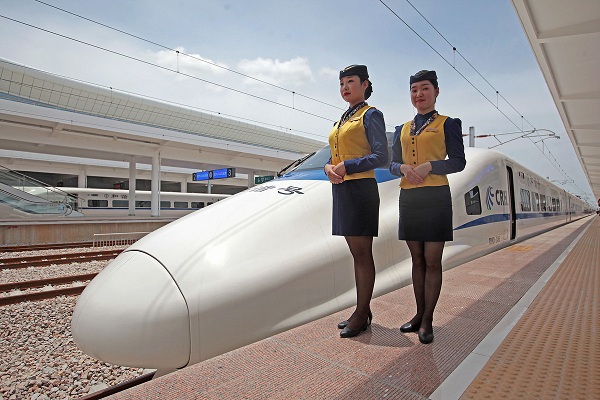Home> News
It's full speed ahead for Zhanjiang's rail hub plan

Two attendants stand by a high-speed bullet train at Zhanjiangxi railway station in Zhanjiang, Guangdong province. [Photo by Wu Weihong/For China Daily]
The high-speed railway, the first in Zhanjiang, connects Zhanjiang with the Shenzhen special economic zone that borders Hong Kong. It has so far served about 15 million passengers, an average of more than 39,000 passengers a day with a maximum daily delivery of 83,000 passengers.
Jiang said the Shenzhen-Zhanjiang high-speed railway and the planning of the Guangzhou-Zhanjiang one will help link Zhanjiang, a major production base in Guangdong, to major cities in the prosperous Pearl River delta. This link will form a two-hour high-speed railway living circle and further expand the cooperation between Zhanjiang and the cities in the Guangdong-Hong Kong-Macao Greater Bay Area in the future, Jiang said.
The Guangdong-Hong Kong-Macao Greater Bay Area includes the cities of Guangzhou, Shenzhen, Foshan, Zhuhai, Zhongshan, Dongguan, Jiangmen, Huizhou and Zhaoqing in Guangdong province, plus the Hong Kong and Macao special administrative regions.
The Zhanjiang-Haikou high-speed railway will link Zhanjiang, home to the gigantic Baosteel project and the Sino-Kuwait chemical projects, to the country's largest special economic zone, playing a major role in serving the construction of the country's largest free trade zone of Hainan province.
The remaining two high-speed railways of Zhanjiang-Hepu and Zhangjiajie-Haikou will help connect Zhanjiang with Guangxi Zhuang autonomous region and Hunan province, he said.
Located in Leizhou peninsula in the southern tip of the mainland, Zhanjiang will further integrate with the construction of the city cluster of Zhanjiang, Maoming and Yangjiang in the western part of Guangdong and the city cluster of Beibu Gulf after all the five high-speed railway lines have begun operations, Jiang said.
He said the addition of the railways will increase Zhanjiang's tourism, commerce, logistics, trade and related industries, playing a significant role in the city's economic development.
Jiang added that Zhanjiang has also planned to build a new international airport and a deep water port in the coming years to fortify its status as a new transportation hub in Guangdong province, following Guangzhou - the provincial capital - and Shenzhen.
Zhanjiang, which borders Guangxi and faces Hainan province, is now one of the major cities in the mainland for advancing economic cooperation and trade ties between China and Southeast Asian nations.

 Print
Print Mail
Mail 5G construction supports Zhanjiang's high-quality development
5G construction supports Zhanjiang's high-quality development
 Acting mayor inspects project construction in Xuwen, Leizhou
Acting mayor inspects project construction in Xuwen, Leizhou Zhanjiang island an "egret paradise"
Zhanjiang island an "egret paradise"  Dancing egrets add vitality to Xiashan
Dancing egrets add vitality to Xiashan